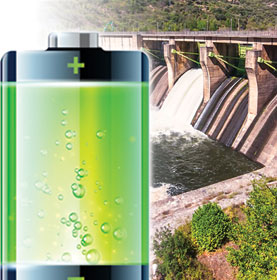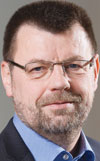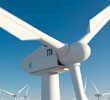

The term ‘renewable energy’ encompasses an array of technologies and is closely tied to many supporting systems, from smart grid communication and charging infrastructures for e-cars through to energy storage. EBV Elektronik has established a Renewable Energies team to address this market by not only providing electronic components, but also advice and support throughout the design phase.
A system can only really be considered ‘smart’ if it offers bidirectional exchange of information and data between the energy generator at one end of the energy transmission chain and the end-user at the other.
This intelligence is enabled by a variety of electronic components: microcontrollers specifically designed for electricity meters, powerline modems, high-performance processors with communication interfaces, efficient power supplies, precise analog circuits or high-voltage semiconductors for the transmission and transformation of the electric current.

As a result, the challenges facing the Renewable Energies team are extremely varied and complex, according to Karl Lehnhoff, the man heading up the new team. According to him, the team’s target groups include any business engaged in generating energy – from photovoltaics through wind energy to biogas.
In addition there is the entire field of energy transport, including high-voltage networks, substations and control technology, as well as net automation, measuring the status of the network, conversion of high voltage into low voltage and adjustable local network transformers. On top of this, the experts also deal with energy storage in relation to renewable energy, including charging stations for electric vehicles.
Last but not least, an important aspect of automation throughout the entire smart grid is communication and, above all, data security. “It’s not just an issue for smart meters, but for all billing-related meters and data concentrators,” stresses Lehnhoff.
Dedicated and networked
Renewable energy has been a core area for EBV for many years now, with market segments including automotive, consumer, renewable energies, healthcare and Hi-Rel. Technology-oriented segments include EBV FPGA, RF and wireless, LightSpeed and identification.
EBV provides support, if required, right from the beginning of a project, as its experts can advise customers on their choice of suitable technology and the right electronic components, as well as assisting in technical matters that arise during development or even during production of new appliances.
There are five dedicated specialists explicitly assigned to deal with renewable energy. They are supported throughout Europe by more than a hundred application engineers and experts from other verticals. “Naturally we didn’t want to establish parallel sales organisations with the verticals, but just to link up expertise and resources,” explains Lehnhoff. “Who provides the support is decided on a case-by-case basis. The industrial sectors are too intensively networked to be sharply segregated.

“So we work together closely, including shared customer visits. After all, how we are organised doesn’t make a difference to the customer. What matters to them is that they receive the right support for their application.” In the end, he says, a customer can’t generally be pigeon-holed.
As an example of how the inter-disciplinary co-operation of the EBV teams can benefit customers, Lehnhoff brings up a smart meter design during which the question arose about communication within the smart home. In this case, the expertise of the RF and wireless experts was also needed.
The adjustable local network transformer integrates measuring technology that enables status monitoring. In the end, it is just the same as condition monitoring from industrial automation and therefore projects like this have interfaces with both the ‘Identification’ vertical segment and with the ‘RF and wireless’ segment where communication or Wi-Fi connection of the adjustable local network transformer is concerned.
In the case of charging stations for electric vehicles, there was co-operation between the renewable energies experts and the automotive specialists at EBV, who, for example, contribute their knowledge where automotive regulations are concerned. “The customer comes to us not with a product specification but wanting a solution for their system,” Lehnhoff points out. “So it’s not just about the hardware, we also have to master the software technique and know all the regulations and standards relevant to the application.”
A major obstacle lies in the fact that, in some areas of renewable energy, there are no integrated regulations. For instance, in the standardisation for short circuits in wind power and PV, different scenarios apply in different countries.

In metering it is even more complex, according to Lehnhoff: “As regards security, in particular, essentially nothing is regulated yet. It will take another five to 10 years. We are also finding that the BSI discussion in Germany has also stimulated thinking about safety in other countries. In other words, there may in the future also be new rules in other countries. They could, however, be less strict than the BSI protection profile.”
How far can the distributor assist with the issue of security? According to Lehnhoff this is a new topic for many customers, and they definitely need support. EBV can provide it in cooperation with third-party software service providers.
As regards security, EBV yet again draws upon its networked organisation, as Lehnhoff explains. “The support of our technology segment, in this case Identification, comes into play again in such issues. The relevant security levels are not specifications for renewable energies, but technical guidelines or challenges which can also be discussed elsewhere; for instance, in connection with the Internet of Things and Industry 4.0.”
EBV has launched a microsite for renewable energy at http://renewableenergies.ebv.com/home/ where visitors can, amongst other things, zoom from the application level to the semiconductor section. This overview allows a click on the relevant product to directly access detailed information such as technical features and logistical details. For more information or to request advice the visitor can send a contact request.
According to Lehnhoff, this website is not intended to replace personal advice, but to be an informative reference tool. “The focus here is on products for use in renewable energy applications that have just come onto the market,” he says. “There is also a summary of manufacturers on our linecard who offer dedicated components tailored to the market, such as a special MCU for metering or power modules for photovoltaics.”
Market potential between growth and price erosion
Renewable energies undoubtedly bring with them great market potential, even though the earlier European euphoria around photovoltaics has long since given way to disenchantment. “On the one hand we have growth, but on the other there is price erosion,” is how Lehnhoff summarises development of the photovoltaics market in general. Things are just as tough for wind energy in Europe. In global terms there are only three European wind power providers still in the top 10.
One of the drivers of renewable energy in Lehnhoff’s opinion is the growing degree of automation of the smart power network. “The greater the share of renewable energy in the power network, the more automation is required. On peak days we, in Germany, already feed in around 50% of the energy from renewable generation. At the same time, the challenge is then to keep the network stable. To handle this task new applications will be required.”
Lehnhoff also believes metering is hugely promising. European Union regulations are largely responsible for this, as they ordain that by 2020, 80% of meters in member states should be smart meters. The smart meters are developed in Europe and experts also expect that the majority of production will take place in Europe.
As for electric vehicles, Lehnhoff acknowledges the need to deal with this politically driven segment. “When the battery systems become more affordable, this market could get going relatively quickly,” he believes. “Otherwise we are still a long way off the planned figures of the German government of one million vehicles in 2020. Our customers are well prepared and have got to grips with the issue early on, but obviously there is still no market yet.”
Finally Lehnhoff points out another interesting recycling application in connection with electromobility: old batteries from electric vehicles could still be used as stationary energy storage in the home. “When the batteries are scrapped, 15 or 10 kWh of the original 20 still remain,” he explains. “Enough, for example, to use them as stationary backup batteries for domestic purposes. That would be very worthwhile in any case, not least as regards environmental protection, which is important to EBV.”
Into the new energy age with EBVChips
With EBVChips, EBV has left its home territory of distribution and, together with manufacturers and customers, developed ICs and modules for various areas of use. With Hermes and Hunter, the company has brought two EBVChips into its range that can be used in renewable energy applications.
Developed jointly with Avago, the Hunter data converter offers an interesting solution for galvanically isolated current measurement. The integral LVDS interface guarantees very good signal integrity in FPGA-based systems such as servo drives or power transformers. The component is suitable for industrial drive technology and also in PV inverters, as well as pitch controls and wing rotation for wind turbines.
Hunter contains an analog input stage with differential inputs for ±200 mV, a second-order sigma/delta modulator, an optical isolation line and the LVDS interface. This means the module is equipped with everything necessary for measurements with a dynamic range of 78 dB.
The appropriate filter can be located in the related FPGA or in a processor. Fitted in an SO-16 package with direct interface for shunts, Hunter offers high DC and AC precision over a wide temperature range. With the Falcon Eye Hunter EBVChips can also offer a reference design suitable for evaluating the Hunter chip.
For energy-saving M-Bus communication, EBV has designed its Hermes EBVChip. This was created in partnership with ON Semiconductor and is essentially an upgrade of a tried and tested IC that has been on the market for 20 years already.
Housed in the space saving QFN-20 package, the M-Bus slave transceiver meets the European standards EN 13757-2 and EN 1434-3, supports communication speeds up to 38 400 Baud and, depending on use, can drive up to six M-Bus loads (repeaters, meter gateways).
Hermes needs very little standby current and also works with low bus voltages. In addition, it has performance features optimised for energy saving operating modes and is therefore ideal for connection to wireless modules. The M-Bus slave system is also equipped with a failsafe function and can be powered from the bus or an external current supply.
For more information contact EBV Electrolink, +27 (0)21 402 1940, [email protected], www.ebv.com
| Tel: | +27 11 236 1900 |
| Email: | [email protected] |
| www: | www.ebv.com |
| Articles: | More information and articles about EBV Electrolink |

© Technews Publishing (Pty) Ltd | All Rights Reserved